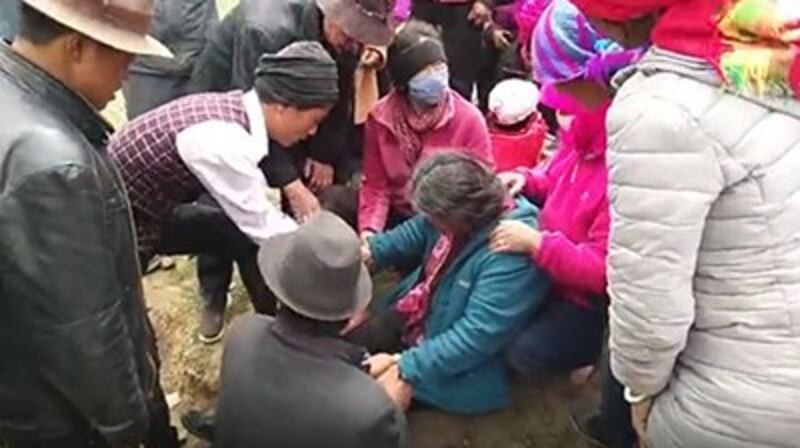UPDATED at 01:45 P.M. on 2017-06-06
Authorities in China’s Qinghai province have arrested more than 40 Tibetans following a clash between villagers and police over water rights that left dozens injured, according to Tibetan sources.
On June 1, Tibetans from Shitsa village, in Tsoshar (in Chinese, Haidong) prefecture’s Bayen (Hualong) Hui Autonomous county, confronted authorities led by Bayen county chief Ma Jinxi over plans to divert their village waterway to nearby Tharga village, the residents of which are mostly Hui Muslim, the sources said.
Security personnel had escorted construction workers and excavators to Shitsa to begin laying pipes that would reroute drinking water from the Yitsa Zachu river to Tharga, the sources said, and when Tibetan residents tried to explain their objections to the project, Ma refused to listen, warning them that he would not be responsible for any "clash or deaths" that arose from a confrontation.
“The river flowing within the territory of Shitsa village was to be diverted towards Tharga village, which is inhabited by Muslims, and this was resisted by the Tibetan villagers,” Dorjee Bum, a Tibetan living in exile who asked that his location not be revealed, told RFA’s Tibetan Service on Friday.
“The dispute escalated into a serious crisis, so armed police arrived at the scene and attempted to quell the situation. In the midst of the tension, the police sided more with Tharga village, and that led the Tibetan protestors to clash with police, leaving 20 Tibetans and 10 police injured.”
According to a second source inside Tibet who spoke on condition of anonymity, and video footage obtained by RFA, Ma ordered police to use tear gas to break up the mob of angry Tibetans and detained two Shitsa village heads. The source said that police had also "fired" on the crowd with what he assumed were non-lethal weapons used for riot control.
In the aftermath, “the Tibetan village community called on the authorities to resolve the dispute fairly and asserted that truth was on the Tibetan side,” the source said.
“They also called on the police to release the two detained leaders.”

Dorjee Bum said that not only were their demands ignored, but authorities had taken additional action against the Shitsa villagers since Thursday’s clash.
“During the past two days … more than 40 [Tibetan] members of Shitsa village were detained,” including the two leaders arrested on Thursday, he said.
The Tibetan source inside Tibet said that 70 Tibetans had been detained after the clash, although 36—including a nine-year-old child and a 70-year-old man—were later released. Several vehicles owned by the residents of Shitsa were also seized, he said.
The official titles of the two detained village leaders and whether any of the other Tibetans detained held official positions was not immediately clear.
But Dorjee Bum said he believed the Tibetans were detained in connection with the injuries police officers suffered during the clash, adding that no Muslims had been arrested.
Meanwhile, he added, the dispute over the diverted water continued Friday.
“More residents from both of the opposed villages arrived at the scene today, and the crisis remains unresolved,” he said.
“Many of those who were injured [in Thursday’s clash] have ended up in the hospital for treatment.”
Of those Tibetans hurt in the clash, one 56-year-old woman had suffered "serious injuries," said the Tibetan in Tibet, adding that the wounded were being treated at a hospital in the Qinghai capital Xining and had been instructed not to speak with anyone about the incident.
Around 40 Tibetan youths from Shitsa had fled into the mountains during the clash, pursued by "hundreds" of police, but escaped due to snow-covered terrain, he said.
In the days since the clash, residents of several other Tibetan communities—such as Goeyok, Lakha and Shingtha village—expressed solidarity with the Shitsa villagers and at one point staged a silent protest in front of the Bayen county government office, he added.
China’s Hui Muslims are largely Sinicized, apart from religious traditions, and live in scattered communities across the country’s Gansu, Qinghai and Yunnan provinces, in addition to Ningxia Hui Autonomous prefecture.
A total of 150 Tibetans living in China have set themselves ablaze in protests since the wave of self-immolations began in 2009. Most protests feature demands for Tibetan freedom and the return of the Dalai Lama from India, where he has lived since escaping Tibet during a failed national uprising in 1959.
Reported by Lhuboom and Thakla Gyal for RFA’s Tibetan Service. Translated by Karma Dorjee. Written in English by Joshua Lipes.
